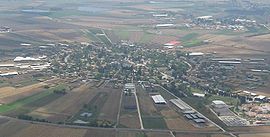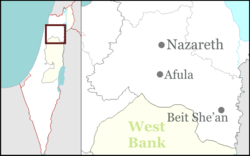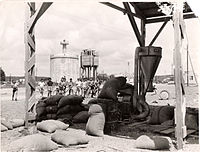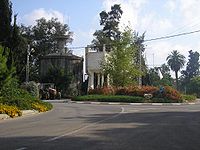- Nahalal
-
Nahalal 
Aerial shot of NahalalHebrew נַהֲלָל Founded 1921 Founded by Immigrant from Eastern Europe Council Jezreel Valley Region Lower Galilee District North Coordinates 32°41′24″N 35°11′48″E / 32.69°N 35.19667°ECoordinates: 32°41′24″N 35°11′48″E / 32.69°N 35.19667°E Population 907[1] (2008) Nahalal (Hebrew: נַהֲלָל), is a moshav in northern Israel.
Its name derives from a Biblical village in the tribe of Zebulun (Joshua 19:15). Covering 8,500 dunams, it falls under the jurisdiction of Jezreel Valley Regional Council. In 2008 it had a population of 907.[1]
Founded in 1921, it was the first moshav ovdim.
Contents
History
The modern moshav was established in 1921. Its founders immigrated to Mandate Palestine from Eastern Europe in what is known as the Second Aliyah and Third Aliyah between 1904 and 1914 (at the end of the Ottoman rule), some of whom had been members of the first kibbutz, Degania. After working in farming communities for a decade, they dreamt of establishing a communal farming community similar to a kibbutz, but they wanted to keep their individual family structure (kibbutzim had communal dining and children slept in separate housing).
The moshav was established on 11 September 1921 on land that had been given to them by the Jewish National Fund.
The small rivulets created marshes, which attracted Anopheles mosquitoes that spread malaria. Heeding the warnings of the experts among them, like Dr. Hillel Yaffe, an expert on the war against malaria, they temporarily settled on a nearby hill, near the Arab village of Ma'lul. Later, the founders came down from the hill and divided the land.
The village layout in Nahalal, devised by architect Richard Kauffman, became the pattern for many of the moshavim established before 1948; it is based on concentric circles, with the public buildings (school, administrative and cultural offices, cooperative shops and warehouses) in the center, the homesteads in the innermost circle, the farm buildings in the next, and beyond those, ever-widening circles of gardens and fields. initially to 80 equal parts, 75 parts to the members and 5 parts for the agricultural school (the first two parts and the last three parts contain the agricultural school). This equal parceling of the land became the trademark geometric shape of Nahalal.
Education
In 1929, a Girls' Agricultural Training Farm was established at Nahalal by Hana Meizel of the Women's International Zionist Organization, and in the 1940s it became a co-educational farming school of the Youth Aliyah movement.
Notable residents
- Assi Dayan, (born 1945), film director, actor, screenwriter, and producer
- Moshe Dayan, Minister of Defense
- Shmuel Dayan
- Yael Dayan, MK and daughter of Moshe
- Yehonatan Geffen, musician
- Amos Hadar, member of the Knesset
- Aryeh Nehemkin, Minister of Agriculture
- Moshe Peled
- Amir Pnueli
- Nissan Rilov
- Meir Shalev, writer
- Hannah Szenes
Note:
- Ilan Ramon, Israel's first and only astronaut, is buried in the Nahalal cemetery, though he never lived in Nahalal.
References
- ^ a b "Locality File" (XLS). Israel Central Bureau of Statistics. 2008. http://www.cbs.gov.il/ishuvim/ishuv2008/bycode.xls. Retrieved 2010-07-10.
External links
- Official website
- Degania & Nahalal UNESCO
- Nahalal Jewish Agency for Israel
- LIFE Magazin, Jul 5, 1937, "Jews made a garden" - aerial photo of Nahalal (page 55), and a girl from Girls' Agricultural Training Farm (page 54), at Google Books.
- 25 Mind-Blowing Aerial Photographs Around the World at twistedsifter.com - better aerial photograph at #9, by Yann Arthus-Bertrand.
Categories:- Jezreel Valley Regional Council
- Moshavim
- Populated places established in 1921
Wikimedia Foundation. 2010.





